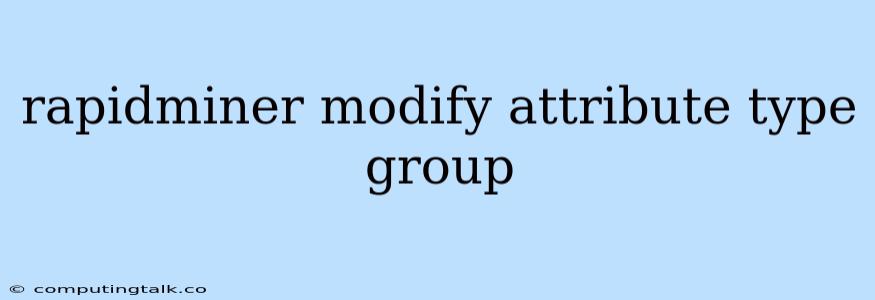RapidMiner is a powerful data science platform that provides a wide range of tools for data preparation, modeling, and analysis. One of the important steps in data preparation is attribute type modification, which involves changing the type of an attribute, such as converting a numerical attribute to categorical or vice versa. This process is crucial for ensuring data integrity and enabling efficient model building.
Why Modify Attribute Type?
Attribute type modification is a fundamental step in data preprocessing, and it's essential for several reasons:
- Improved model performance: Different machine learning algorithms have specific requirements for the type of data they can handle. By modifying attribute type, you can prepare your data to be compatible with the chosen algorithm, leading to improved accuracy and efficiency.
- Data consistency: Inconsistent data types can lead to errors and inconsistencies during analysis. Modifying attribute type ensures that all attributes are represented in a consistent manner, facilitating accurate calculations and interpretations.
- Feature engineering: Attribute type modification can be used as a feature engineering technique, creating new attributes from existing ones, which can improve the predictive power of your models.
How to Modify Attribute Type in RapidMiner
RapidMiner offers a variety of operators for modifying attribute type, each with specific functionalities. Here are some of the most commonly used operators:
**1. ** Replace operator: This operator replaces the values of an attribute with new values based on a specific rule or function. It can be used to modify attribute type by converting numerical values to categorical labels or vice versa.
**2. ** Discretize operator: This operator discretizes a numerical attribute by dividing its range into discrete intervals. This is useful for transforming continuous variables into categorical ones, which might be required by certain algorithms.
**3. ** String to Number operator: This operator converts a string attribute into a numerical attribute. This is helpful when your data includes numerical values represented as strings.
**4. ** Number to String operator: This operator converts a numerical attribute into a string attribute. This can be used to represent numerical values as text labels.
Group Attribute Type Modification
RapidMiner allows you to modify attribute type in a group of attributes simultaneously. This is particularly helpful when you need to perform the same transformation on multiple attributes.
**1. ** Using the Modify operator: The Modify operator can be used to apply a specific transformation to multiple attributes simultaneously. You can specify the desired transformation, such as converting multiple attributes to categorical or numerical, in one operation.
**2. ** Using the "Group" attribute: You can create a "Group" attribute that categorizes your attributes based on their type. Then, you can use the Group operator to apply transformations based on the group membership.
Tips for Modifying Attribute Type
Here are some tips for effectively modifying attribute type in RapidMiner:
- Understand your data: Before modifying attribute type, it's essential to understand the characteristics of your data and the purpose of your analysis.
- Consider the algorithm: Choose the appropriate attribute type based on the specific requirements of the machine learning algorithm you plan to use.
- Experiment with different options: There might be several ways to modify attribute type for a given attribute. Experiment with different operators and transformations to find the best approach for your data.
- Monitor the impact: After modifying attribute type, monitor the impact on the performance of your model. Ensure that the transformation improves your model's accuracy and doesn't introduce unintended biases.
Examples of Modifying Attribute Type
Example 1: Converting a numerical attribute to categorical
Let's say you have an attribute named "Age" representing customer age in years. To create an age group category, you can use the Discretize operator to divide the age range into different intervals (e.g., 0-18, 19-30, 31-45, 46+). This will transform the numerical "Age" attribute into a categorical "Age Group" attribute.
Example 2: Converting a string attribute to numerical
If you have a string attribute "Gender" with values "Male" and "Female", you can use the Replace operator to convert these strings to numerical values (e.g., "Male" -> 1, "Female" -> 0). This will allow you to use the "Gender" attribute in numerical algorithms.
Conclusion
Modifying attribute type is an essential step in data preprocessing, enabling you to improve model performance, ensure data consistency, and perform effective feature engineering. By utilizing the appropriate operators and techniques provided by RapidMiner, you can effectively modify attribute type and optimize your data for machine learning tasks. By following the tips outlined in this article, you can gain a better understanding of the nuances of attribute type modification and maximize the benefits of this process in your data science workflows.
